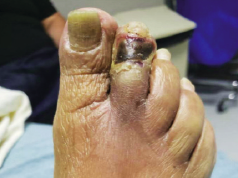
The Cardiovascular and Interventional Society of Europe (CIRSE) have announced that patient enrolment for the CALCIO trial has begun. CALCIO started patient enrolment on 15 July, 2024, with the goal of recruiting 400 chronic limb-threatening ischaemia (CLTI) patients over the next two years.
CALCIO is a prospective, observational cohort study that is collecting real-world data on the use of intravascular lithotripsy (IVL) with the Shockwave Medical IVL system (Shockwave Medical) to disrupt vascular calcifications in patients with CLTI. The study was initiated and is co-chaired by Raman Uberoi (The John Radcliffe Hospital, Oxford, UK), Peter Reimer (Municipal Clinic Karlsruhe, Karlsruhe, Germany) and Christoph Binkert (MRI Bahnhof Oerlikon, Zurich, Switzerland).
Once patient enrolment is complete, an additional two years will be dedicated to the collection of patient follow-up data to ensure the study meets its objectives. Currently, there are several sites enrolled from Germany and the UK. More centres from Germany, the UK, France, Austria, Italy, Greece and Canada are in the recruitment process and are expected to join soon.
Next Research, CIRSE’s contract research organisation (CRO), is the administrator of CALCIO and is managing the study on a day-to-day basis, the press release states. Their team asked the CALCIO initiators and principal investigators to share their thoughts on the study’s significance, their experiences so far, and the importance of generating more clinical evidence. They also encouraged other centres to participate in this research effort.
Binkert shared: “I think CALCIO is an important registry because it collects real-world data on a very severe problem, as patients with CLTI need to get revascularisation and if they have very calcified arteries, this is a big challenge and the current evidence is not sufficient.”
Reimer said: “As interventional radiologists, we should learn to collect outcome data that looks at the long-term prognosis of patients. This is exactly what we will do with the CALCIO study. We’ll look at the amputation rate and wound healing through the use of IVL. That is why we should all try to enrol as many patients as possible in the CALCIO study.”
Joo-Young Chun, principal investigator (St. George’s University Hospital, England, UK), highlighted what makes CALCIO so special: “I am very excited to be part of the study. What makes CALCIO quite unique is that it takes real-world patients with very wide inclusion criteria and very few exclusion criteria. I am also happy that the outcome measures are clinically focused. We are talking about CLTI patients, so these are patients with the risk of losing their legs, and we are looking at wound healing and also amputation-free survival. We are not necessarily focusing on how the lesion performs with IVL, but on how the patient does. Another exceptional thing about CALCIO is that we are looking at quality of life, which is quite unusual in such studies, and it would be very interesting to see how patients perceive their treatment and how it is affecting their quality of life.”
Raghuram Lakshminarayan (Hull University Teaching Hospital, England, UK) principal investigator, emphasised the significance of addressing calcification: “Calcification is a huge problem for the medical community, especially with peripheral arterial disease. We saw this in the pulmonary system, and we now realise that this is a major issue in peripheral arterial disease, and IVL has come as a new technique in order to try to deal with this problem of calcification in peripheral arteries. CIRSE has set up this unique registry to look at exactly how IVL is going to work over a period of time. There have been a lot of studies, but we want to have a large population to look at over a long period of time for us to get to the bottom of how IVL modifies calcium and the outcomes when we treat these patients. CALCIO is a great registry, and I think you should add every patient with CLTI to this study!”












